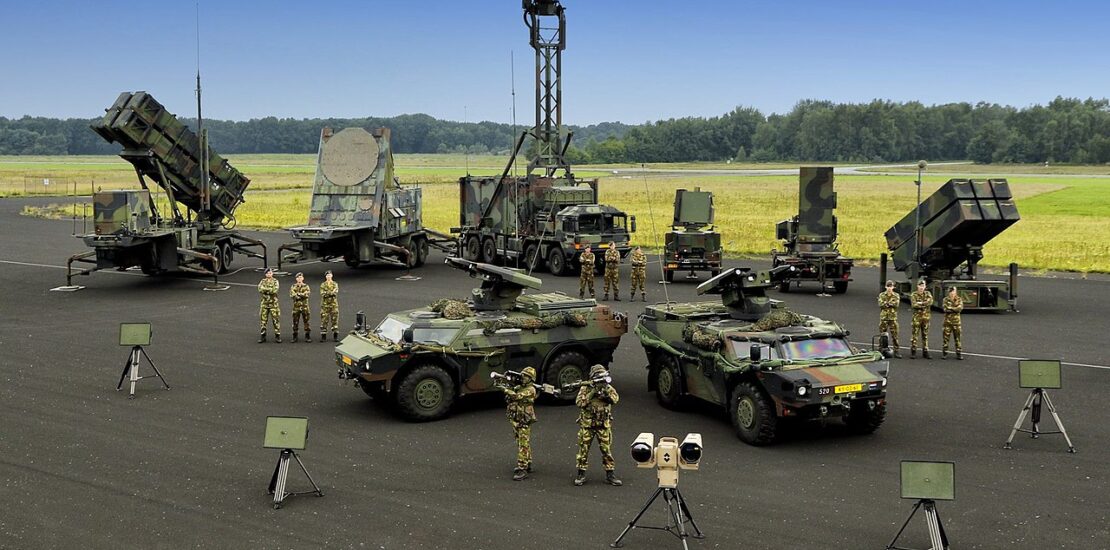Mobile Air Defense Systems
- March 1, 2024
- Posted by: Dean Patterson
- Category: Organization and Processes

As the war in Ukraine continues to unfold, it’s increasingly clear that this conflict marks a watershed moment in the evolution of modern warfare, with ground-based air defense (GBAD) systems at the heart of the strategic chessboard. Amidst the backdrop of this prolonged engagement, the effectiveness, adaptability, and strategic depth of air defense systems are being tested as never before. From the Donbas to Kyiv, Ukraine’s air defense strategies have revealed critical insights into the future of military engagements, highlighting both the indomitable spirit of resistance and the harsh realities of modern combat.
The conflict is showcasing GBAD’s pivotal role in defending territory, safeguarding civilian populations, critical infrastructure, and shaping the operational tempo of the war. Innovative tactics, such as the use of mobile air defense units that blend seamlessly into the local terrain, have emerged as game-changers, offering a glimpse into the future of asymmetrical warfare. These strategies have blunted the edge of aerial assaults and forced a reevaluation of air dominance in the 21st century.
“As the world watches, the lessons learned from the Ukrainian theater of war are setting new paradigms for how nations prepare for, engage in, and ultimately deter aggression from the skies,” said Lt. Gen. Keith Stalder (USMC, ret.), KSA Integration’s founder and CEO.
Mobile Air Defense Systems’ Crucial Role
One of the standout lessons from Ukraine is the paramount importance of mobile air defense systems capable of optimizing camouflage, concealment, and decoys (CCD) while acquiring, tracking, and engaging aviation platforms. These systems have been extraordinarily effective in denying air superiority to the adversary, a testament to their strategic value on the modern battlefield. Ukraine’s adept use of tactics like shoot-and-scoot and dispersion complicated Russian strike operations and showcased the effectiveness of mobile defenses against more traditional, and perhaps outdated, forms of aviation-delivered weapons.
Large-Scale Aviation Strike Missions and Precision Weapons
The conflict in Ukraine has highlighted significant challenges in executing large-scale aviation strike missions. Russia’s inability to organize massed air refueling operations, crucial for sustaining large-scale aerial attacks, starkly illustrates the logistical and tactical difficulties faced by modern air forces. Meanwhile, the underperformance of combined arms strategies by Russian forces emphasizes the complexity of effectively integrating different military branches. Additionally, this war shows the necessity of precision-guided munitions in modern warfare. Adequate supplies of such munitions are essential for the effectiveness of air defense and offensive operations, pointing to a broader requirement for precision in contemporary military engagements.
Anticipating Air Power and New Warfare Realities
Ukraine’s proactive measures in air defense preparation, notably the early dispersion of assets and the acquisition of MANPADS, show the importance of anticipation. These efforts effectively countered Russian air capabilities, demonstrating the strategic foresight necessary for contemporary military planning. Evidently, emerging technologies and innovative tactics have reshaped the dynamics of the battlefield. The integration of unmanned aerial systems (UASs), precision guided munitions, and mobile air defense systems marks a significant shift towards a new era of warfare, where advanced manned strike platforms are no longer a decisive advantage.
Monitoring Russia’s Actions
Russia’s focus on radar coverage and air defense capabilities, particularly against low-altitude drones, underscores the evolving nature of aerial threats. In an effort to fortify defenses against unmanned aerial vehicles (UAVs), Russia has been expanding its radar network, especially around critical areas like Moscow, employing technologies from the Almaz-Antey Air Defense Concern. It has also integrated advanced systems such as the Tor-M2, Buk-M2, Buk-M3, and S-300 PM-4, alongside the application of electronic warfare to disrupt drone-operator links. This development points to a significant emphasis on countering UAVs, which have become a staple in warfare. Now, dominance in the air increasingly depends on the ability to counteract remotely controlled devices effectively.
Strategic and Tactical Lessons for Future Conflicts
The war in Ukraine has underscored the critical need for international collaboration in defense strategy and technology sharing. The deployment of advanced Western air defense systems, alongside homegrown solutions, has created a multi-layered defense network that challenges the very notion of air superiority. As UASs begin to integrate artificial intelligence and mass-produced expendable UAVs increase autonomous capabilities, the requirement to field low cost-per-shot GBAD systems that can engage drone swarms and advance missile threats will compel greater collaboration on defensive means.
“In this crucible of conflict, the strategic implications of GBAD extend far beyond the immediate battlefield. They are reshaping national security policy, alliance dynamics, and the global arms trade. As nations around the world digest these lessons, the war in Ukraine serves as a stark reminder of the enduring importance of ground-based air defense in preserving sovereignty and peace in an increasingly uncertain world,” said Stalder.
At the same time, this war offers critical strategic and tactical lessons for the future. Among the key takeaways are the significance of mobility, rapid adaptability, and the integration of low-cost, high-volume precision munitions for defensive and offensive combat operations. These lessons have profound implications for military strategy. The conflict illustrates the need for modernization of air defense capabilities and possibly new doctrinal approaches to address the challenges of modern warfare. The effectiveness of mobile air defense systems in Ukraine may well prompt a reevaluation of air defense strategies worldwide, emphasizing the need for mobility, adaptability, and technological superiority.
To learn more about KSA Integration’s work on this topic, please contact Dean Patterson, KSA’s Senior Advisor for Ground-Based Air Defense.
Sources:
https://www.usni.org/magazines/proceedings/2023/september/air-denial-lessons-ukraine
https://cissm.umd.edu/research-impact/publications/how-ukraine-fought-against-russias-air-war
https://www.hudson.org/lessons-ukraine-future-war-can-kasapoglu
https://warontherocks.com/2022/04/ukraine-shows-why-taiwan-needs-more-air-defense/
https://news.rambler.ru/army/52222751-uroki-svo-chto-izmenilos-v-sisteme-pvo-rf-za-dva-goda/
https://tass.ru/armiya-i-opk/4842017
About KSA Integration
KSA Integration, LLC, is a Service- Disabled Veteran-owned Small Business (SDVOSB) that was founded by LtGen Keith Stalder (USMC, Ret.) and Bryan Altmire in November 2010. KSA Integration offers a comprehensive portfolio of support capabilities in three critical areas: 1) Data Science and Analytics, 2) Warrior Care, and 3) Business Process Improvement. For more information visit us at www.ksaintegration.com or contact info@ksaintegration.com.
